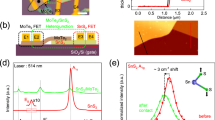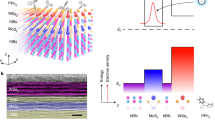Abstract
Low power consumption in the static and dynamic modes of operation is a key requirement in the development of modern electronics. Tunnel field-effect transistors with direct band-to-band charge tunnelling and steep-subthreshold-slope transfer characteristics offer one potential solution. However, silicon and III–V heterojunction-based tunnel field-effect transistors suffer from low on-current densities and on/off current ratios at sub-60 mV decade–1 operation. Tunnel field-effect transistors based on two-dimensional materials can offer improved electrostatic control and potentially higher on-current densities and on/off ratios. Here we report gate-tunable heterojunction tunnel triodes that are based on van der Waals heterostructures formed from two-dimensional metal selenide and three-dimensional silicon. These triodes exhibit subthreshold slopes as low as 6.4 mV decade–1 and average subthreshold slopes of 34.0 mV decade–1 over four decades of drain current. The devices have a current on/off ratio of approximately 106 and an on-state current density of 0.3 µA µm–1 at a drain bias of –1 V.
This is a preview of subscription content, access via your institution
Access options
Access Nature and 54 other Nature Portfolio journals
Get Nature+, our best-value online-access subscription
$29.99 / 30 days
cancel any time
Subscribe to this journal
Receive 12 digital issues and online access to articles
$119.00 per year
only $9.92 per issue
Buy this article
- Purchase on Springer Link
- Instant access to full article PDF
Prices may be subject to local taxes which are calculated during checkout





Similar content being viewed by others
Data availability
The data that support the conclusions of this study are available from the corresponding authors upon reasonable request. Source data are provided with this paper.
Code availability
Any codes used in this study are available from the corresponding authors upon request.
References
Cao, Q., Tersoff, J., Farmer, D. B., Zhu, Y. & Han, S.-J. Carbon nanotube transistors scaled to a 40-nanometer footprint. Science 356, 1369–1372 (2017).
Iannaccone, G., Bonaccorso, F., Colombo, L. & Fiori, G. Quantum engineering of transistors based on 2D materials heterostructures. Nat. Nanotechnol. 13, 183–191 (2018).
Li, X. et al. Emerging steep-slope devices and circuits: opportunities and challenges. in Beyond-CMOS Technologies for Next Generation Computer Design (eds Topaloglu, R. O. & Wong, H. S. P.) 195–230 (Springer International Publishing, 2019).
Wu, F. et al. Vertical MoS2 transistors with sub-1-nm gate lengths. Nature 603, 259–264 (2022).
Illarionov, Y. Y. et al. Ultrathin calcium fluoride insulators for two-dimensional field-effect transistors. Nat. Electron. 2, 230–235 (2019).
Desai, S. B. et al. MoS2 transistors with 1-nanometer gate lengths. Science 354, 99–102 (2016).
Vandenberghe, W. G. et al. Figure of merit for and identification of sub-60 mV/decade devices. Appl. Phys. Lett. 102, 013510 (2013).
Lu, H. & Seabaugh, A. Tunnel field-effect transistors: state-of-the-art. IEEE J. Electron Devices Soc. 2, 44–49 (2014).
Fiori, G. et al. Electronics based on two-dimensional materials. Nat. Nanotechnol. 9, 768–779 (2014).
Duong, N. T. et al. Gate-controlled MoTe2 homojunction for sub-thermionic subthreshold swing tunnel field-effect transistor. Nano Today 40, 101263 (2021).
Yan, X. et al. Tunable SnSe2/WSe2 heterostructure tunneling field effect transistor. Small 13, 201701478 (2017).
Roy, T. et al. Dual-gated MoS2/WSe2 van der Waals tunnel diodes and transistors. ACS Nano 9, 2071–2079 (2015).
Britnell, L. et al. Field-effect tunneling transistor based on vertical graphene heterostructures. Science 335, 947–950 (2012).
Nourbakhsh, A., Zubair, A., Dresselhaus, M. S. & Palacios, T. Transport properties of a MoS2/WSe2 heterojunction transistor and its potential for application. Nano Lett. 16, 1359–1366 (2016).
Liu, Y., Huang, Y. & Duan, X. Van der Waals integration before and beyond two-dimensional materials. Nature 567, 323–333 (2019).
Huang, M. et al. Multifunctional high-performance van der Waals heterostructures. Nat. Nanotechnol. 12, 1148–1154 (2017).
Lv, R. et al. Two-dimensional transition metal dichalcogenides: clusters, ribbons, sheets and more. Nano Today 10, 559–592 (2015).
Novoselov, K. S., Mishchenko, A., Carvalho, A. & Castro Neto, A. H. 2D materials and van der Waals heterostructures. Science 353, aac9439 (2016).
Bae, S.-H. et al. Integration of bulk materials with two-dimensional materials for physical coupling and applications. Nat. Mater. 18, 550–560 (2019).
Akinwande, D. et al. Graphene and two-dimensional materials for silicon technology. Nature 573, 507–518 (2019).
Jariwala, D., Marks, T. J. & Hersam, M. C. Mixed-dimensional van der Waals heterostructures. Nat. Mater. 16, 170–181 (2017).
Li, M. et al. High mobilities in layered InSe transistors with indium-encapsulation-induced surface charge doping. Adv. Mater. 30, 1803690 (2018).
Lyding, J. W., Hess, K. & Kizilyalli, I. C. Reduction of hot electron degradation in metal oxide semiconductor transistors by deuterium processing. Appl. Phys. Lett. 68, 2526–2528 (1996).
Hess, K., Kizilyalli, I. C. & Lyding, J. W. Giant isotope effect in hot electron degradation of metal oxide silicon devices. IEEE Trans. Electron Devices 45, 406–416 (1998).
Ciampi, S., Harper, J. B. & Gooding, J. J. Wet chemical routes to the assembly of organic monolayers on silicon surfaces via the formation of Si–C bonds: surface preparation, passivation and functionalization. Chem. Soc. Rev. 39, 2158–2183 (2010).
Linford, M. R., Fenter, P., Eisenberger, P. M. & Chidsey, C. E. D. Alkyl monolayers on silicon prepared from 1-alkenes and hydrogen-terminated silicon. J. Am. Chem. Soc. 117, 3145–3155 (1995).
Ionescu, A. M. & Riel, H. Tunnel field-effect transistors as energy-efficient electronic switches. Nature 479, 329–337 (2011).
Miao, J. et al. Gate-tunable semiconductor heterojunctions from 2D/3D van der Waals interfaces. Nano Lett. 20, 2907–2915 (2020).
Murali, K., Dandu, M., Das, S. & Majumdar, K. Gate-tunable WSe2/SnSe2 backward diode with ultrahigh-reverse rectification ratio. ACS Appl. Mater. Interfaces 10, 5657–5664 (2018).
Wang, C. et al. Gate-tunable diode-like current rectification and ambipolar transport in multilayer van der Waals ReSe2/WS2 p–n heterojunctions. Phys. Chem. Chem. Phys. 18, 27750–27753 (2016).
Sarkar, D. et al. A subthermionic tunnel field-effect transistor with an atomically thin channel. Nature 526, 91–95 (2015).
Sangwan, V. K. & Hersam, M. C. Electronic transport in two-dimensional materials. Annu. Rev. Phys. Chem. 69, 299–325 (2018).
Jariwala, D. et al. Band-like transport in high mobility unencapsulated single-layer MoS2 transistors. Appl. Phys. Lett. 102, 173107 (2013).
Martinez-Pastor, J., Segura, A., Julien, C. & Chevy, A. Shallow-donor impurities in indium selenide investigated by means of far-infrared spectroscopy. Phys. Rev. B 46, 4607–4616 (1992).
Hopkinson, D. G. et al. Formation and healing of defects in atomically thin GaSe and InSe. ACS Nano 13, 5112–5123 (2019).
Si, M. et al. Steep-slope hysteresis-free negative capacitance MoS2 transistors. Nat. Nanotechnol. 13, 24–28 (2018).
Tomioka, K., Yoshimura, M. & Fukui, T. Steep-slope tunnel field-effect transistors using III–V nanowire/Si heterojunction. In 2012 Symposium on VLSI Technology (VLSIT) 47–48 (IEEE, 2012).
Shin, G. H. et al. Vertical-tunnel field-effect transistor based on a silicon–MoS2 three-dimensional–two-dimensional heterostructure. ACS Appl. Mater. Interfaces 10, 40212–40218 (2018).
Kim, S. et al. Thickness-controlled black phosphorus tunnel field-effect transistor for low-power switches. Nat. Nanotechnol. 15, 203–206 (2020).
Keck, P. H. & Broder, J. The solubility of silicon and germanium in gallium and indium. Phys. Rev. 90, 521–522 (1953).
Higashi, G. S., Becker, R. S., Chabal, Y. J. & Becker, A. J. Comparison of Si(111) surfaces prepared using aqueous solutions of NH4F versus HF. Appl. Phys. Lett. 58, 1656–1658 (1991).
Madelung, O., Rössler, U. & Schulz M. Indium selenide (InSe) Debye temperature, heat capacity, density, melting point. in Non-Tetrahedrally Bonded Elements and Binary Compounds I Vol. 41C (SpringerMaterials, 1998).
Acknowledgements
D.J. and J.M. acknowledge primary support for this work by the Air Force Office of Scientific Research (AFOSR) FA9550-21-1-0035. D.J. also acknowledges partial support from the Intel Rising Star Award and the University Research Foundation (URF) at Penn. D.J. also acknowledges partial support from the University of Pennsylvania Materials Research Science and Engineering Center (MRSEC) (DMR-1720530) in addition to the usage of MRSEC-supported facilities. The sample fabrication, assembly and characterization were carried out at the Singh Center for Nanotechnology at the University of Pennsylvania, which is supported by the National Science Foundation (NSF) National Nanotechnology Coordinated Infrastructure Program grant NNCI-1542153. A.V.D. and S.K. acknowledge the support of Material Genome Initiative funding allocated to NIST. H.Z. acknowledges support from the US Department of Commerce, National Institute of Standards and Technology, under the financial assistance awards 70NANB19H138. T.B. and N.G. acknowledge support from the AFOSR under award no. FA9550-19RYCOR050.
Author information
Authors and Affiliations
Contributions
D.J. and J.M. conceived the idea/concept. D.J. directed the collaboration and execution. J.M. fabricated all the devices with assistance from B.S. and measured them with the assistance of X.L. Simulations were done by C.L., J.W., Y.G. and W.H. Electron microscopy and cross-sectional cutting of the devices was performed by H.Z. InSe crystals were grown by S.K. A.V.D. supervised the crystal synthesis, Hall measurements and electron microscopy. N.G. and T.B. performed the photoemission spectroscopy measurements. J.M., C.L. and D.J. co-wrote the manuscript with contributions from all the authors. Certain commercial equipment, instruments or materials are identified in this paper to specify the experimental procedure adequately. Such identification is not intended to imply recommendation or endorsement by the National Institute of Standards and Technology, nor is it intended to imply that the materials or equipment identified are necessarily the best available for the purpose.
Corresponding authors
Ethics declarations
Competing interests
D.J. and J.M. have filed an invention disclosure based on this work. The other authors declare no competing interests.
Peer review
Peer review information
Nature Electronics thanks Vincent Tung and the other, anonymous, reviewer(s) for their contribution to the peer review of this work.
Additional information
Publisher’s note Springer Nature remains neutral with regard to jurisdictional claims in published maps and institutional affiliations.
Disclaimer: Certain commercial equipment, instruments, or materials are identified in this paper to specify the experimental procedure adequately. Such identification is not intended to imply recommendation or endorsement by the National Institute of Standards and Technology, nor is it intended to imply that the materials or equipment identified are necessarily the best available for the purpose.
Supplementary information
Supplementary Information
Supplementary Figs. 1–15, Sections 1–4 and Tables 1 and 2.
Source data
Source Data Fig. 2
Room-temperature electrical characteristics and band diagrams of InSe/p++Si 2D/3D HJ-TTs.
Source Data Fig. 3
Room-temperature electrical characteristics of InSe/Si 2D/3D HJ-TTs, control 2D InSe MOSFETs and TCAD-simulated devices.
Source Data Fig. 4
Temperature-dependent electrical characteristics of InSe/Si 2D/3D HJ-TTs.
Source Data Fig. 5
Performance comparison of the InSe/Si 2D/3D HJ-TTs with reported sub-thermionic homo- and heterojunction TFETs and NC-FETs.
Rights and permissions
Springer Nature or its licensor holds exclusive rights to this article under a publishing agreement with the author(s) or other rightsholder(s); author self-archiving of the accepted manuscript version of this article is solely governed by the terms of such publishing agreement and applicable law.
About this article
Cite this article
Miao, J., Leblanc, C., Wang, J. et al. Heterojunction tunnel triodes based on two-dimensional metal selenide and three-dimensional silicon. Nat Electron 5, 744–751 (2022). https://doi.org/10.1038/s41928-022-00849-0
Received:
Accepted:
Published:
Issue Date:
DOI: https://doi.org/10.1038/s41928-022-00849-0
This article is cited by
-
Steep-slope vertical-transport transistors built from sub-5 nm Thin van der Waals heterostructures
Nature Communications (2024)
-
Reconfigurable, non-volatile neuromorphic photovoltaics
Nature Nanotechnology (2023)
-
High-performance violet phosphorus photodetectors with van der Waals-assisted contacts
Science China Physics, Mechanics & Astronomy (2023)



